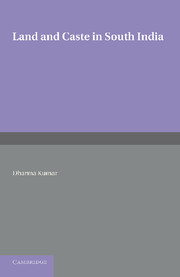 Land and Caste in South India
Land and Caste in South India Book contents
- Frontmatter
- Dedication
- CONTENTS
- List of Tables and Figures
- Acknowledgements and A Note on Certain Connventions
- Abbreviations
- Map of the Madras Presidency
- PART I
- I INTRODUCTION
- II THE AGRARIAN BACKGROUND
- III FORMS OF AGRESTIC SERVITUDE
- IV THE IMPORTANCE OF AGRICULTURAL LABOUR IN THE FIRST HALF OF THE NINETEENTH CENTURY
- V OFFICIAL POLICY AND THE EMANCIPATION OF THE AGRICULTURAL LABOURER
- VI OFFICIAL POLICY: LAND TENURES AND LAND REVENUE
- PART II
- Glossary
- Bibliography
- Index
V - OFFICIAL POLICY AND THE EMANCIPATION OF THE AGRICULTURAL LABOURER
from PART I
Published online by Cambridge University Press: 05 June 2016
- Frontmatter
- Dedication
- CONTENTS
- List of Tables and Figures
- Acknowledgements and A Note on Certain Connventions
- Abbreviations
- Map of the Madras Presidency
- PART I
- I INTRODUCTION
- II THE AGRARIAN BACKGROUND
- III FORMS OF AGRESTIC SERVITUDE
- IV THE IMPORTANCE OF AGRICULTURAL LABOUR IN THE FIRST HALF OF THE NINETEENTH CENTURY
- V OFFICIAL POLICY AND THE EMANCIPATION OF THE AGRICULTURAL LABOURER
- VI OFFICIAL POLICY: LAND TENURES AND LAND REVENUE
- PART II
- Glossary
- Bibliography
- Index
Summary
Since the British officials of the time felt that many of the agricultural labourers of Madras Presidency, and in some other parts of India too, were ‘slaves’, India was bound to come within the scope of the anti-slavery movement in England, whatever the realities of the situation. But in fact their belief had sufficient basis not to make the connection with the abolitionist movement absurd; that many agricultural labourers were in some form of bondage or other was patent, and though the forms of servitude differed in many respects from the types of slavery familiar to European experience, certain features were similar. In Malabar, for instance, the labourers could be bought, sold and mortgaged. And in the early part of the century at least, in nearly all courts of law, following what were considered the traditional Indian practices ‘slaves’ were not allowed to testify in cases concerning themselves. Since the term ‘slave’ appears so frequently in the literature and since the measures we will discuss in this chapter were directed against those features of South Indian servitude which were more or less the attributes of full slavery, the term will be used more freely in this chapter than elsewhere.
But in spite of these attributes, slavery in India was very different from slavery in the West Indies or Brazil. The bonded labourer was an integral part of his society, belonging to the same race and culture as his master. He had certain rights as well as obligations, and in any case the traditional institutions of servitude had been modified over a long period of time and did permit a certain social mobility. At first at least, the new rulers were reluctant to take steps that might mean the destruction of the whole social and economic structure, and in any case their power to emancipate the labourer was limited precisely by the fact that he was so rooted in agrarian society.
Before British rule began, the labourer in most of the Telugu areas had already won his freedom, in a formal sense at least. Servitude persisted in both the West Coast and the Tamil areas, but it was in the latter that social mobility was the more likely. Here there was probably no formal prohibition against the ownership of land by the lower castes.
- Type
- Chapter
- Information
- Land and Caste in South IndiaAgricultural Labour in the Madras Presidency during the Nineteenth Century, pp. 64 - 76Publisher: Cambridge University PressPrint publication year: 2013


